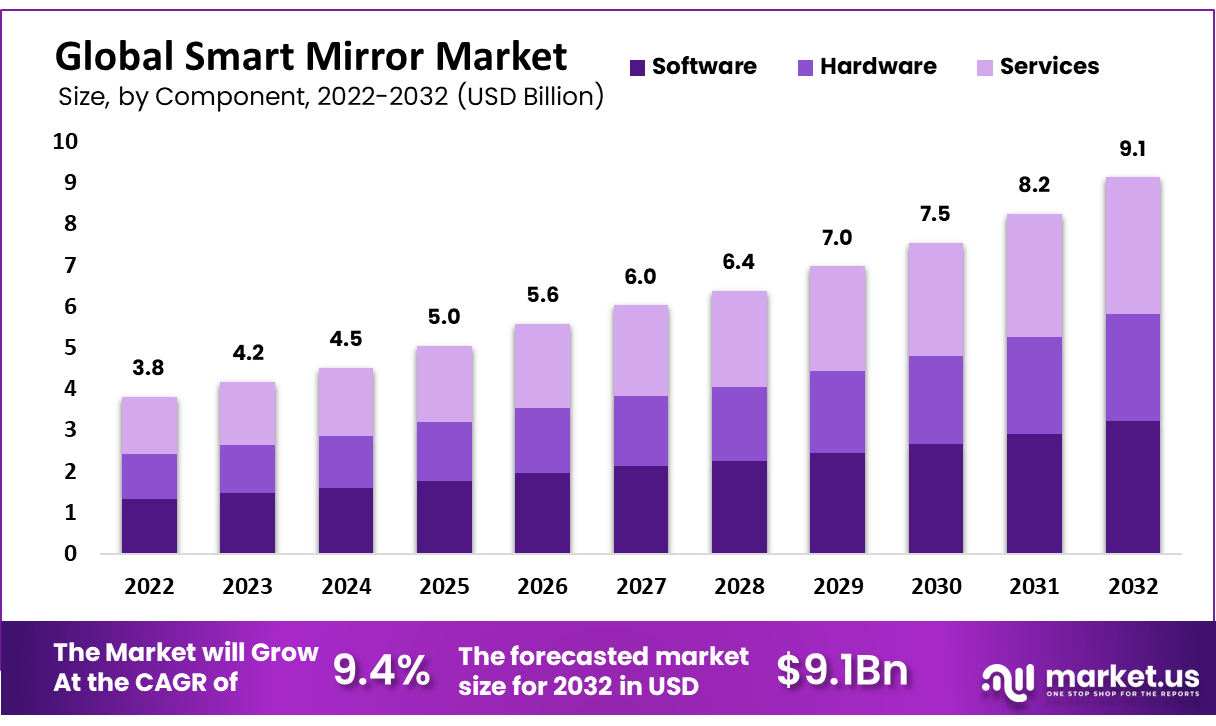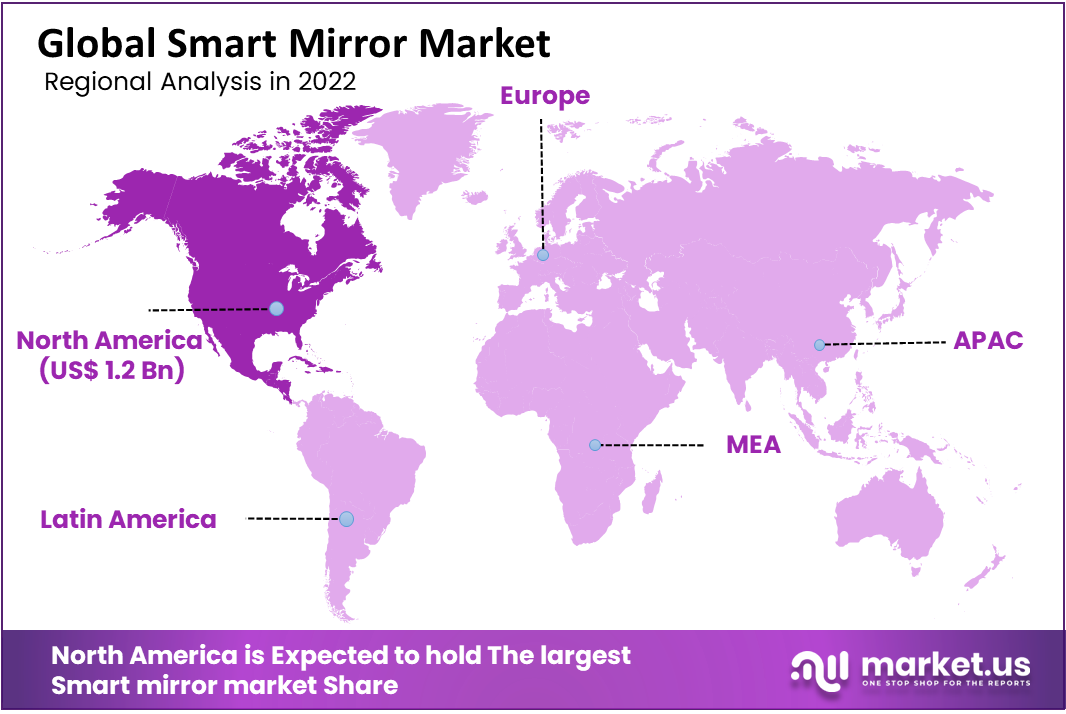Table of Contents
Introduction
Smart Mirror Statistics: A smart mirror is a technologically enhanced mirror that integrates digital displays, sensors, and connectivity features to provide an interactive and informative user experience.
It combines the traditional function of a mirror with modern technology to offer a range of features beyond simple reflection.
Smart mirrors can display a wide range of information on the mirror’s surface. This information includes weather forecasts, times, dates, news updates, calendar events, etc.
Smart mirrors continue to evolve, incorporating new technologies and features. That enhances their usability and usefulness in various contexts, from homes to retail stores and beyond.

Editor’s Choice
- The Global Smart Mirrors Market was valued at approximately $3.8 billion in 2022. It is projected to experience a Compound Annual Growth Rate (CAGR) of 9.4% from 2023 to 2032.
- The touchscreen segment is foreseen to possess a 55% share of the market
- The without touch screen segment is expected to hold a 45% share between 2023 and 2032.
- North America took the lead in the smart mirrors market, holding a dominant share of over 32.5% in revenue.
- Meanwhile, the Asia-Pacific region is poised for substantial growth at a Compound Annual Growth Rate (CAGR) exceeding 10.2%.
- Most surveyed individuals from Generation Z in the United States expressed familiarity with smart mirrors, which allow virtual product testing.
- In contrast, a mere 18 percent of respondents from the baby boomer generation indicated their awareness of smart mirrors.
- In the United States, a compact smart mirror could be priced under $100. While a mid-sized variant might range between $150 and $300.
- The energy consumption of an LCD-based smart mirror can range from around 30 to 100 watts or more. depending on factors like the display size. The backlighting technology used, and the brightness level.
Global Smart Mirror Market Size
- Between 2022 and 2032, the revenue generated from the global smart mirror market is expected to demonstrate a consistent upward trajectory.
- Starting at 3.8 billion USD in 2022, the market revenue is projected to progressively rise to 4.2 billion USD in 2023 and further increase to 4.5 billion USD in 2024.
- This growth trend continues as the market is forecasted to reach 5 billion USD in 2025 and expand to 5.6 billion USD in 2026.
- The momentum persists as the years unfold. With the market revenue climbing to 6 billion USD in 2027 and 6.4 billion USD in 2028.
- The market is then anticipated to breach the 7 billion USD mark in 2029. Reaching 7.5 billion USD in 2030 and 8.2 billion USD in 2031.
- The upward trajectory culminates with an estimated market revenue of 9.1 billion USD in 2032.
- It is projected that from 2022 to 2032. This market will experience a growth rate of 9.41 percent annually.
(Source: Market.us)

Smart Mirror Statistics – Market Size by Segment
- Categorized by product type, the global smart mirror market is divided into two segments: touch screen mirrors and mirrors without touch screens.
- The touchscreen segment is foreseen to possess a 55% market share. Driven by its enhanced efficiency and more affordable pricing than touch-screen-based mirrors, which appeal to a broader income demographic.
- The without touch screen segment is also expected to hold a 45% share between 2023 and 2032.
(Source: Market.us)

Regional Market Analysis
- North America took the lead in the smart mirrors market, holding a dominant share of over 32.5% in revenue. This can be attributed to the accessibility and affordability of effective products. Like coated glazing and the implementation of conservation regulations in the region. Local companies are responding to consumer needs by offering tailored products.
- Meanwhile, the Asia-Pacific region is poised for substantial growth at a Compound Annual Growth Rate (CAGR) exceeding 10.2%. The region’s production is expected to experience the highest CAGR. The driving forces behind this growth include an increased demand for luxury vehicles and a rise in disposable income.
- In 2020 the Chinese smart fitness mirror market was valued at 30 million yuan.
- Predictions indicate substantial growth within the next five years, with the market projected to expand to exceed 11 billion yuan. These smart fitness mirrors are designed to exhibit workout metrics and guide exercises.
(Source: Market.us, Statista)
Take advantage of our unbeatable offer - buy now!


Smart Mirror Statistics – Applications of Smart Mirror
- During 2021, most of the surveyed individuals in China indicated their familiarity with smart mirrors, which enable virtual product testing.
- In contrast, most participants from other countries involved in the research reported being unaware of smart mirror technology.
- Furthermore, China emerged as the forefront country regarding smart mirror ownership. With 15 percent of Chinese beauty consumers acknowledging possessing such mirrors.
- Smart interactive mirrors find utility in various hospitality establishments such as hotels and spas. Offering guests an exclusive and engaging encounter beyond the ordinary. In 2022, the interactive mirrors market revenue stood at USD 2.7 billion, which increased to USD 3.15 billion in 2023.
- This positive momentum continued as the figures climbed to USD 3.68 billion in 2024 and USD 4.3 billion in 2025.
- Subsequent years witnessed a consistent expansion, with revenues reaching USD 5.02 billion in 2026 and further escalating to USD 5.86 billion in 2027.
- The trend of ascending revenues continued through 2028 when the figure reached USD 6.85 billion, and by 2029, it surged to USD 8 billion.
- As the market maintained its upward trajectory, revenue figures continued to soar, reaching USD 9.35 billion in 2030 and USD 10.92 billion in 2031.
- The growth curve remained steep as revenues surged to USD 12.75 billion in 2032, followed by USD 14.9 billion in 2033, underlining a consistent and remarkable expansion in market value over the years.
(Source: Marketresearch.biz, Global Consumer Survey on Beauty & Cosmetics-2021)

User Demographics
- Most surveyed individuals from Generation Z in the United States expressed familiarity with smart mirrors, which allow virtual product testing.
- In contrast, a mere 18 percent of respondents from the baby boomer generation indicated their awareness of smart mirrors.
(Source: 2021 Global Consumer Survey on Beauty & Cosmetics)
Cost of Smart Mirror Statistics
United States
- In the United States, a compact smart mirror could be priced under $100, while a mid-sized variant might range between $150 and $300.
- For larger mirrors, the cost could surpass $400.
- The Raspberry Pi is the favored choice for creating smart mirrors.
- A full kit, including all necessary connectors, can be purchased for approximately $50 to $80.
- A film applied to regular glass would generally cost about $20-50, while high-quality plexiglass could be priced around $150.
- For a suitable two-way mirror, the cost might be around $200.
(Source: Amazon Services LLC)
India
- A basic smart mirror could start from around ₹5,000 to ₹10,000, while more advanced models with larger screens and additional features could range from ₹15,000 to ₹50,000 or even higher.
(Source: Economic Times)
Europe
- In Europe, similar to other regions, basic smart mirrors might start around €100 to €200, while more advanced and larger models with additional features could range from €300 to €800 or more.
(Source: CNET)

Environmental and Energy Considerations
- The energy consumption of an LCD-based smart mirror can range from around 30 to 100 watts or more, depending on factors like the display size, the backlighting technology used, and the brightness level.
- LED-backlit LCDs are more energy-efficient than older CCFL (Cold Cathode Fluorescent Lamp) backlit displays. However, they can still consume a noticeable amount of power, especially when operating at higher brightness levels.
- The smart mirror operates on mains power of 110V or higher and comes equipped with a three-pin plug. The plug can be detached to connect to a lighting ring if desired.
- The energy usage is minimal, and considering the average electric rates in the UK, the annual cost of operation is estimated to be less than £2.
(Source: EIA, SmartMirrorUK)
Emerging Technologies – Smart Mirror Statistics
- A majority exceeding 70% of consumers express reduced inclination towards in-store shopping in the present day.
- Additionally, over 80% of consumers express enthusiasm regarding integrating augmented reality (AR) for product interactions, creating fresh prospects for the fusion of smart mirrors with AR technology.
- While the concept of smart mirrors has its roots in the fitness sector, it’s important to note that this technology isn’t novel. Forward-looking brands have been exploring the realm of smart mirrors since as early as 2010.
(Source: Internet Retailing)
Recent Developments
Acquisitions:
- Gentex Corporation’s Strategic Investment in ADASKY: In May 2023, Gentex Corporation announced a strategic investment in ADASKY. A leader in Long Wave Infrared (LWIR) sensor technology. This investment aims to facilitate the introduction of ADASKY’s proprietary technology into the smart mirror market, enhancing safety and performance features.
- Magna International’s Expansion in Canada: In February 2023, Magna International announced a USD 470 million investment to expand its operations in Ontario, Canada. This expansion includes a new facility for battery enclosures to support electric vehicles, which complements Magna’s smart mirror technology initiatives.
New Product Launches:
- Seura’s Vanity Mirrors: In January 2022, Seura launched a new range of vanity mirrors tailored for residential and hospitality applications. These mirrors come with advanced features such as integrated lighting, touch controls, and connectivity with smart home systems.
- Capstone Connected’s Thin Cast Smart Mirror: Launched in December 2021, Capstone Connected introduced. The Thin Cast Smart Mirror features an 18.5-inch touchscreen display, Android compatibility, and dual speakers. This product is aimed at both residential and commercial markets.
Funding:
- Gentex’s Series B Funding for ADASKY: Gentex Corporation led a Series B funding round for ADASKY, providing significant capital to develop and commercialize their sensor technologies, which are critical for smart mirror advancements.
Market Growth:
- Global Market Expansion: The growth is driven by the increasing adoption of smart home technologies and advancements in display and sensor technologies.
- Regional Insights: North America holds a significant share of the smart mirror market, driven by high consumer interest in connected devices and smart home solutions. The Asia-Pacific region is also expected to witness substantial growth due to technological advancements and increasing demand in countries like China, Japan, and South Korea.
Conclusion
Smart Mirror Statistics: Smart mirrors have emerged as innovative, multifunctional devices that seamlessly blend traditional functionality with digital technology.
Integrating displays, touch interfaces, voice recognition, and connectivity options has opened up new possibilities for enhancing daily routines, improving user experiences, and transforming various industries.
The popularity of smart mirrors is on the rise, driven by increased interest in smart home technology and the desire for convenient, streamlined information access.
Smart mirrors are utilized by a wide range of individuals, from tech enthusiasts and homeowners to businesses in retail and hospitality sectors, each benefiting from the tailored features offered by these devices.
As technology matures and adapts to changing user preferences and demands, smart mirrors will likely play a significant role in shaping the intersection of technology and everyday life.
FAQs
A smart mirror is a reflective surface that incorporates digital technology, such as a display screen, to provide information and perform various functions while functioning as a traditional mirror.
Smart mirrors often include features like displaying time, weather updates, calendar events, fitness tracking, voice control, and integration with other smart home devices.
The popularity of smart mirrors has been steadily growing due to increased interest in smart home technology and the desire for multifunctional devices.
Smart mirrors are used by diverse individuals, including tech enthusiasts, homeowners, businesses (such as retail and hospitality), and anyone looking to streamline their daily routines.
Smart mirrors offer convenience by consolidating information in one place, serving as a decorative element, and providing hands-free interaction through voice and gesture control.
Discuss your needs with our analyst
Please share your requirements with more details so our analyst can check if they can solve your problem(s)



